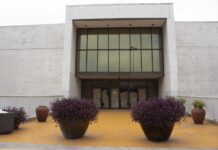Author: Soo Jin Kim
Fefu and Her Friends will premiere at Keck Theater on November 7 at 7:30 p.m., followed by a post-show discussion with Director Alan Freeman. The theater department began working on Fefu and Her Friends in August, auditioning and casting the characters, designing the costumes and the set.
Often referred to as an American avant-garde classic, the play was written by Marie Irene Fornes in the 1970s. Cuban-born Fornes came to America as a young girl and devoted her time to exploring theater and writing short and full-length plays. Her plays, though not commercially successful, have played an important role in the history of theater.
Freeman highly regards Fornes and her works. “I’ve always been interested in women’s issues,” he said. “There are many themes covered in this play, particularly about the identity of women. The 1930s seems to me like a distant mirror in which the audience can see the problem of an oppressive society. [Because it is set in the 1930s], it is not so threatening, not so confrontational as having the play set in modern time. It also gives wonderful roles to our women actresses here.”
Fefu and Her Friends explores the psychology of women. The play is divided into three acts and showcases the relationships and interactions between friends. Filled with both painful and happy memories, the play also deals with the dangers of women becoming intellectual during the 1930s. The women in the play are all college-educated and live in a society that represses intellectual women. One character has hallucinations, two were former lovers and another has to deal with a crumbling marriage and fears that she will go crazy because of it.
Laura Wong (senior), a costume design major, is in charge of creating costumes for the play. Preparations began after reading through the script in August. “I tried to understand the characters first, and after doing research on the 1930s, started to combine the clothing style of that time period with the characters in the play,” Wong said.
Students enrolled in Theatre 121 helped in the process with students from the work-study shop, an all-year program for students interested in theater. “There are three ways to get costumes after designing,” Wong said. “You can either borrow costumes from other colleges, pull or make them.” “Pull” refers to costumes from previous plays being “pulled from the attic.” The flowery dress of one of the characters, Cindy, was borrowed from Pomona and was originally the dress used for Fefu in Pomona’s own production of the play. “It’s really interesting how the same costumes can be used in so many different ways,” Wong said. “Some of our hats were altered from their original forms. It’s like the recycling of costumes.”
“Laura is a really talented young designer, and Rachel Levy has really helped in designing the lighting,” Freeman said, discussing his delight in having two seniors aid in producing the play.
Fefu and Her Friends is full of unexpected events. Unlike most plays, the audience is divided into four groups for Act II, with each group moving to a different location than the stage. These four smaller spaces allow the audience to experience intimate psychological views of the characters in comparison to Act I and Act III. During Act II, the main lobby is transformed into a study, the kitchen scene is held backstage, the Green Room has a bedroom scene while the lawn outside is set for a scene in which two friends discuss genitalia while cleaning vegetables together. While this is happening, student musicians will be playing in each of these four spaces-a string quartet, a jazz combo, a jazz guitar and a ragtime piano. These scenes are repeated four times so the audience will have the chance to see each of the four separate individual scenes.
“This is a funny, poignant play, while it is a tragic comedy,” Freeman said. “We’ve got a water fight on stage, singing, shotgun blasts and even dancing.” He added that he was glad to do this play at Oxy, to “keep alive the push for gender equality.” He said he hopes the audience will leave the play “having experienced both joy and terror living life as a woman.”
This article has been archived, for more requests please contact us via the support system.
![]()




































